Since more than 2 million researchers have set up ORCID profiles, chances are pretty good that you're at least somewhat familiar with ORCID. Scholars around the world have set up ORCID profiles containing information, and/or links to, their publications, research activities, grants, awards, and other information pertinent to their scholarly work and professional connections. While the primary goal of ORCID is to ensure the correct attribution of individual researchers, integrations are available for other platforms commonly used by scholars, like Scopus, ISNI, and ResearcherID. With an ORCID profile, a researcher can then use his or her ORCID ID - the persistent digital identifier that connects to your profile on the ORCID platform - to help with cross-referencing authors or publications.
For the scholars indexed in the ACI Scholarly Blog Index, while they have a number of social and professional platforms to include in their profiles, including ORCID offers a unique advantage in that any books and journal articles contained in their ORCID profiles will automatically populate the Books and Journal Articles tabs on an ACI author profile page (click here to see a live example). If those ORCID profiles contain no information, however, those publication entries won't be pulled through - and while a number of researchers had already set up a profile in ORCID, fewer researchers had already filled in the data that would make their profiles in ORCID comprehensive and informative for researchers and other scholars. Over the past few years, we've worked with a large number of scholars who had long ago set up an ORCID profile, but had not taken the additional steps needed to add their publications and activities. In many cases, those scholars were pleasantly surprised to find out how easily they could have been adding their scholarly bodies of work into ORCID all along.
With those and other researchers in mind, this blog post will provide step-by-step instructions on how to add journal articles, books, and other scholarly activities to an author profile in ORCID.
Note: If you don't already have an ORCID profile, you can register for free on the ORCID website; your name and email address is all that's required to register. Be sure to check with your university or organization, however, as some organizations provide institutional account access to their students and faculty or employees. That institutional account may offer organizational identifiers and connections that you might find beneficial.
When logged into your ORCID account, the primary landing page will show your personal information and various types of research and professional activities, including degrees and certificates, employment details, publications, and/or grants and other funding-related awards. In ORCID, traditional publication types like books, dissertations, journal articles and newspaper or magazine articles are referred to as works, as are other research outputs, like data sets, conference posters, lectures or speeches, performances, and materials published online. In addition, there are several options for classifying those outputs that don't neatly fit within a named selection.
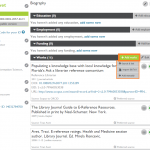
To add publications and other scholarly work to your ORCID profile, click on or hover over the Add Works button in the Works section of your author information page, and then select one of the following sub-options: Search & link, Import BibTeX, or Add manually. A brief description of each type is provided below, followed by step-by-step instructions on adding works to an ORCID profile using each of those three methods.
- Search & link: Select this option to search common indexes or research communities for your scholarly works. Once located, the correct work(s) can then easily be imported into ORCID.
- Import BibTeX: Select this option to import BibTeX (.bib) files, which are plain text files used by various citation platforms. You can easily use this option for any works located in Google Scholar.
- Add manually: Select this option to add the details of a given work manually. ORCID will arrange and format the details you provide, so don't hesitate to add your works manually if you can't import them using the other options.
ORCID Works: Search & Link
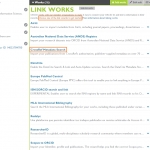
To add works using the Search & link option, click or hover over Add Works and then click on Search & link. This will display a list of link wizards for various databases, indexes, and other platforms - such as DataCite, PubMed Europe, CrossRef Metadata Search, ResearcherID, and Scopus - on which you may search for your scholarly works. Just click on the title of the platform you wish to start with; if you don't find the information needed, you can go back and search remaining platforms. In this example, I'll click on CrossRef Metadata Search to start the CrossRef wizard.
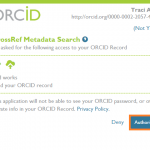
A dialog will display requiring you to confirm that you're allowing the product - in this case, CrossRef - to access your ORCID record. Click on the Authorize button to continue. This will allow the link wizard to search the chosen product for your scholarly records.

A search results page from that platform will display any records found with your name. Records that are already in the Works section of your ORCID profile will have an IN YOUR PROFILE designation below the bibliographic data for each entry, while those that are not already in ORCID will display ADD TO ORCID. Once you've chosen the desired publication or other work, click on ADD TO ORCID.
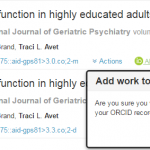
A small pop-up will ask you to confirm that you want to add the entry to your ORCID profile. Click on Yes to continue. This will complete the import and add the selected work to your ORCID Works list.
ORCID Works: Import to BibTeX

The Import to BibTeX option works by allowing you to upload a .bib file from your computer directly into ORCID. To add this or other works using the Import to BibTeX option, click or hover over Add Works and then click on Import to BibTeX.
This will display a small section containing a brief description of the BibTeX option and a Choose File button. If you have the desired .bib file already saved on your computer, click on Choose File and select the .bib record to import that entry into ORCID.
NOTE: Some citation and reference management platforms, like EndNote, work well with .bib files. However, Google Scholar is one of the most popular sources of .bib files for researchers, and you can easily get a .bib file from any Google Scholar entry - and you don't have to be logged in to do so. Here are instructions for retrieval:
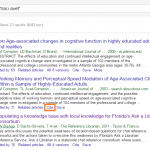
To retrieve a .bib file via Google Scholar, run a Google Scholar search for your name or other details of the work, then click on the Cite link located just below the entry.
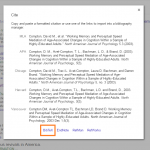
A pop-up will display various citation style options, along with some linked options at the bottom. Click on the BibTeX linked option located in the lower-left corner of the dialog.
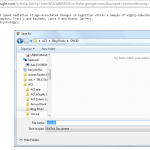
The resulting webpage will display a white background and a plain-text citation. Right-click anywhere on this page and select Save as. Rename your file if desired. When saved, the file will be a .bib file.
ORCID Works: Add Manually
To add works manually, click or hover over Add Works and then click on Add Manually. You will need to do this for each item you wish to manually add to ORCID. Clicking on Add Manually will display an empty form allowing you to fill in various fields for whatever details you have available on the publication.

On this form, you'll first need to select a work category, and then a work type that falls under the selected category. The work category describes a broader work designation and offers 4 options: Publication, Conference, Intellectual Property, or Other. For example, if you choose the work category Publication, you'll then select from such work types as book, dissertation, and various types of articles. Choosing the work category Other will offer type options like data set, speech or lecture, and artistic performance.
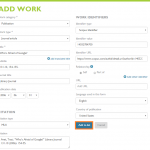
Once your work category and work type are selected, the rest of the form includes empty fields that you will manually enter information into. In addition to basic bibliographic data, there are also fields for other types of information you may also wish to include, such as an item description or another professional identifier. Once you've entered all of the information you have available on the work in question, click on the Add to list button in the lower-right corner.
For each work added to ORCID, regardless of the Add Works method you used to import that information, you'll see a View Details icon (arrow) in the upper-right and an Edit icon (pencil) in the lower-left of the entry, both of which you'll probably use fairly often when adding to or maintaining your ORCID selection of works. It is advisable to click on the View Details icon for each new work added, as this will display a more detailed set of the bibliographic data set for that item. In some cases, you'll only notice errors or omissions in the complete record when viewing the full entry through that icon.
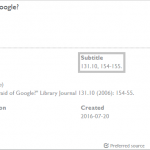
In this example, clicking on the View Details icon allows me to see that inadvertently pasted volume and issue data into the subtitle field when filling out my form. Now that I'm aware of my error, I can simply click on the Edit icon to delete or revise that field.
Which method do you find most effective for adding new publications and activities to your ORCID profile? Do you have a favorite method for adding works to ORCID, or any other ORCID tips you'd like to share with other researchers? Please let us know in the comments field below.








